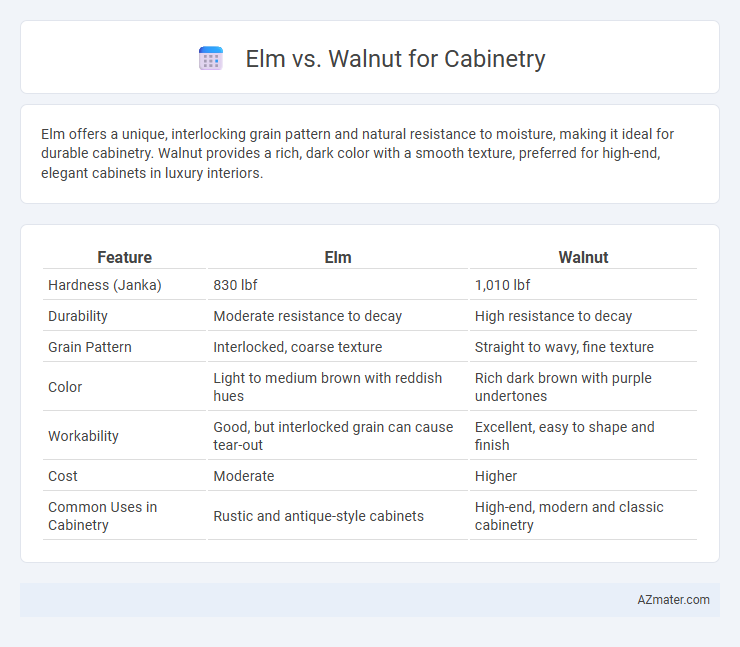Elm offers a unique, interlocking grain pattern and natural resistance to moisture, making it ideal for durable cabinetry. Walnut provides a rich, dark color with a smooth texture, preferred for high-end, elegant cabinets in luxury interiors.
Table of Comparison
| Feature | Elm | Walnut |
|---|---|---|
| Hardness (Janka) | 830 lbf | 1,010 lbf |
| Durability | Moderate resistance to decay | High resistance to decay |
| Grain Pattern | Interlocked, coarse texture | Straight to wavy, fine texture |
| Color | Light to medium brown with reddish hues | Rich dark brown with purple undertones |
| Workability | Good, but interlocked grain can cause tear-out | Excellent, easy to shape and finish |
| Cost | Moderate | Higher |
| Common Uses in Cabinetry | Rustic and antique-style cabinets | High-end, modern and classic cabinetry |
Introduction: Elm vs Walnut in Cabinetry
Elm wood offers a distinctive grain pattern and impressive durability, making it a popular choice for cabinetry that requires a rustic or traditional look. Walnut is prized for its rich, deep brown color and smooth texture, often selected for high-end cabinetry demanding elegance and long-lasting strength. Both woods provide excellent workability and resistance to wear, but walnut's premium aesthetic and natural stability often position it as the preferred option for luxury cabinetry projects.
Wood Characteristics: Elm and Walnut Compared
Elm wood exhibits a distinctive interlocking grain pattern, providing strong resistance to splitting and excellent shock absorption, making it a durable choice for cabinetry. Walnut features a fine, straight grain with a rich, deep brown color that darkens over time, offering a luxurious and elegant appearance. Both woods are hardwoods, but Elm tends to be tougher and more flexible, while Walnut is prized for its smooth texture and superior finish quality.
Appearance and Grain Patterns
Elm cabinetry features an appealing interlocking grain pattern with a natural wavy or cross-grain texture, offering a rustic and warm appearance ideal for traditional or farmhouse styles. Walnut, known for its rich, deep chocolate-brown color with occasional purplish hues, boasts a straight grain with occasional curls or waves, providing a luxurious and elegant look suited for contemporary or high-end designs. The contrasting grain complexity between elm's more varied texture and walnut's smoother, more refined patterns makes each wood type uniquely desirable for cabinetry aesthetics.
Durability and Strength
Walnut offers superior durability and strength compared to elm, making it ideal for cabinetry that requires long-lasting performance and resistance to wear. Elmwood, while moderately strong, is more prone to dents and scratches due to its interlocking grain structure. Walnut's dense, hard nature enhances its ability to withstand heavy use in cabinetry applications.
Workability and Ease of Crafting
Elm wood offers excellent workability due to its interlocking grain, which provides good resistance to splitting, making it suitable for detailed cabinetry work. Walnut is prized for its smooth texture and uniform grain, allowing for precise cuts and a fine finish, but it can be slightly more challenging to work with hand tools because of its density. Both woods respond well to sanding and finishing, though walnut often requires sharper tools for clean craftsmanship.
Cost and Availability
Elm wood offers a mid-range cost for cabinetry, balancing affordability with durability, while walnut tends to be significantly more expensive due to its rich color and premium quality. Availability of elm is generally higher, with many hardwood suppliers stocking it in various grades, whereas walnut can be less accessible and often requires special ordering or sourcing from specific regions. Cabinet makers favor elm for budget-conscious projects without compromising strength, whereas walnut is preferred for premium, high-end cabinetry due to its aesthetic appeal and rarity.
Finishing and Staining Properties
Elm wood offers a coarse, interlocking grain that absorbs stains unevenly, requiring pre-conditioning for a uniform finish in cabinetry. Walnut features a smooth, fine grain with natural dark brown hues, allowing it to take stains well and often needing minimal finishing to enhance its rich appearance. Both woods are durable, but walnut's finishing properties typically provide a more consistent and aesthetically pleasing result for high-end cabinetry.
Maintenance and Longevity
Elm wood offers moderate maintenance requirements due to its natural resistance to splitting and warping, making it suitable for cabinetry in stable indoor environments. Walnut, renowned for its dense grain and hardness, requires less frequent refinishing and exhibits superior longevity, maintaining its aesthetic appeal over decades. Both woods respond well to regular cleaning and protective finishes, but walnut's durability provides a longer-lasting investment for high-traffic kitchen or bathroom cabinets.
Environmental Considerations
Elm wood is known for its fast growth and ability to thrive in diverse climates, making it a more sustainable choice compared to walnut, which grows slower and requires specific conditions. Walnut harvesting can lead to higher environmental impacts due to longer growth cycles and increased resource consumption. Choosing elm for cabinetry supports eco-friendly practices by reducing deforestation pressures and lowering carbon footprints associated with wood production.
Choosing Between Elm and Walnut for Your Cabinets
Elm offers a distinct grain pattern with good durability and moderate hardness, making it a cost-effective yet attractive option for cabinetry. Walnut provides a rich, dark color with exceptional strength and fine grain, ideal for high-end, luxurious cabinet designs. Choosing between elm and walnut depends on budget considerations, desired aesthetic, and the level of wear resistance required for your cabinetry.

Infographic: Elm vs Walnut for Cabinetry
 azmater.com
azmater.com